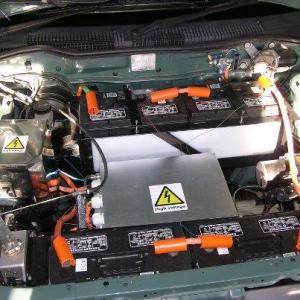| Owner | Chris Northover | ||||||||
|---|---|---|---|---|---|---|---|---|---|
| Location | Wanganui, Wanganui New Zealand map | ||||||||
| Web/Email | WebPage | ||||||||
| Vehicle | 1993 Nissan Sentra SGS This model is a "liftback" model. So chosen because of its useful format; the rear seats fold down and give a good sized luggage space in the rear. The batteries are carried four in the front and six in the back. The liftback gives good access above the rear batteries, which are stored in a newly fabricated well where the spare wheel well was cut out. The top of the battery case is 200mm above the original boot floor, so suits the extra space of the liftback. It is sealed with a nylon cover, itself covered with marine ply. | ||||||||
| Motor | Permanent Magnet DC 120 volt, nominal power; 11KW (14.7 HP) Peak power 22KW (29.5 HP). It is a Rare Earth Permanent Magnet brushless motor. Not sure if anyone else is running one of these. Only rated at 11kw/22kw, but seems to pull as well as higher rated "brushed" motors. | ||||||||
| Drivetrain | Manual 5 speed operating without a clutch. ATF instead of gear oil for lower resistance. The motor is attached to the front of the gear box through an aluminium adapter plate, and drive is through the collar of the clutch welded to a Toyota drive shaft spline. Mounts have been fabricated from steel (square section, round, flat and angle) and attached to the original engine and gearbox mountings. | ||||||||
| Controller | Provided by factory along with the motor. The controller senses motor position and sends measured width pulse of electricity through one of three cables. Just a stepper motor, really. Very smooth system with very little heat loss. | ||||||||
| Batteries | 10 Exide DC12v115, 12.00 Volt, Lead-Acid, Flooded As supplied for fork lifts. 30 kgs each | ||||||||
| System Voltage | 120 Volts | ||||||||
| Charger | 120 volt DC /230 volt AC charger with usual algorithms giving programmed charging. | ||||||||
| Heater | 1 x 370 ohm ceramic wound coil from a Conray heater running from the 120 volt traction circuit. This is fitted in a stainless steel base contained in a high density plastic frame. It is switched by a 12 volt solenoid controlled by on/off switch, together with two thermal cut-outs (80C on the stainless base, and 70C on the outer body of the heater near the element). I will also fit a thermostat into that circuit. | ||||||||
| DC/DC Converter | Iota DLS 45 120 volt AC or DC input, 12 volt output. | ||||||||
| Instrumentation | Paktrakr, original electronic speedo (off gearbox) battery compartment ventilation indicator light, brake vacuum warning, traction motor circuit live. | ||||||||
| Top Speed | 62 MPH (99 KPH) 100 kph in fifth gear. Limited in speed by the model of controller I am using; the newer controller maxes out at 4500rpm using the same motor, instead of 2800/3200 rpm my "older" one does. The new one also has "Regen". | ||||||||
| Acceleration | Probably less than the acceleration of the petrol engine I removed, but around town I don't notice it; I normally drive quite conservatively, and the seven minutes it takes to get into town in my Honda Civic has not changed when I use the battery car. | ||||||||
| Range | 60 Miles (96 Kilometers) 90 - 100 (kms) | ||||||||
| Watt Hours/Mile | I think it is 345 Whrs/km. Watch this space... | ||||||||
| EV Miles |
| ||||||||
| Seating Capacity | 4 adults. | ||||||||
| Curb Weight | 2,690 Pounds (1,222 Kilograms) 1220 KGs. It weighs about 10 kg less in the front, and 100kg more in the rear than in original state. | ||||||||
| Tires | 175/60/14, pumped up to 40 psi. | ||||||||
| Conversion Time | About a year on and off. I stopped work on it completely for about four months at the end of 2011 when a contract appeared. | ||||||||
| Conversion Cost | About $US9000, but this includes repairs to car, re-registration, certification, insurance etc. | ||||||||
| Additional Features | The motor is a Rare Earth, permanent magnet, brushless motor. It goes very well, and runs cool. Only disappointment is the range, but it has been cold, and perhaps my driving technique needs work. I have fitted a Sollit Electronics Ventilation timer; this great little device runs a computer type 80mm permanent magnet fan. The fan turns on when I open the fuel filler flap to charge the vehicle; then turns off ten minutes after I close the flap when the vehicle is charged. Also, it shows a red LED if the fan should "hang" for any reason or get blocked by a mouse or anything... Another feature is the Voltage Leakage detector (also from Sollit Electronics) which will alert me if a short between the 120+ volt traction circuit and the chassis should arise; good idea, because 120 volts DC can kill you! | ||||||||
| I am really quite pleased with the end result. Driving this car is no different in effect to driving my ICE car; I get to places in town as fast as if I was using petrol; only a lot cheaper. If I was to do another project I would spend more money at the beginning and buy a much newer donor car in better condition. Why spend $NZ11,000 and a year's work on a project car when you only end up with a 19 year old Nissan? However, I can't stress enough the value of cleaning the donor car inside and out before you begin. Water blast, brush, wipe, and make sure you shampoo the seats at the end of the conversion process. I made the mistake of buying a car from a scrap yard; great condition, seized motor, not too many miles, but unknown to me, when the motor went west, the previous owner had used it as a dog kennel! Took a lot of time and hard work to get the smell and the dog hair out. I had a bad cold the day I bought it so couldn't smell anything; imagine my surprise when my sense of smell returned... | |||||||||
Copyright © 1997-2025 by Mike Chancey










